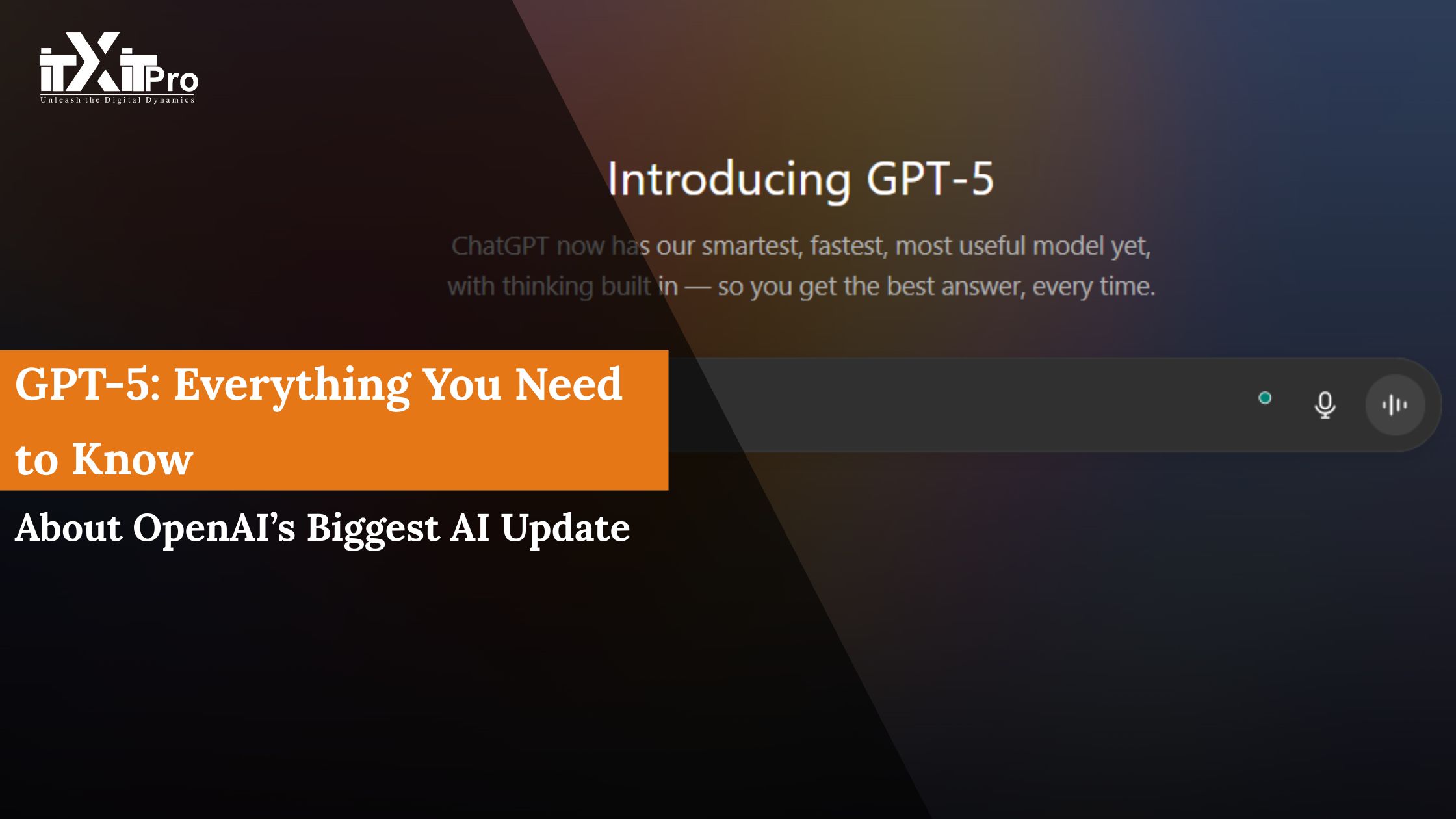
The AI world is buzzing with excitement as OpenAI launches GPT-5, the most powerful and versatile version of its generative pre-trained transformer models yet. If you’ve been following the AI evolution, you know that each iteration—from GPT-3 to GPT-4o—has set new benchmarks in natural language understanding, creativity, and real-world usability.
But GPT-5 isn’t just an upgrade. It’s a massive leap forward, redefining how businesses, marketers, developers, and content creators use AI. In this comprehensive guide, we break down everything new in GPT-5, compare it to GPT-5 Pro and older models like GPT-4o and GPT-3, and help you decide which version is right for your needs.
What Is GPT-5 and Why Is It a Game-Changer?
GPT-5 is the latest generation of OpenAI’s language models, designed to understand and generate human-like text with remarkable accuracy and depth. It goes beyond just text generation to integrate multimodal capabilities — processing images, audio, and video alongside text. Here are the standout features:
1. Multimodal Understanding and Generation
Unlike previous models that focused mainly on text, GPT-5 is truly multimodal. This means it can interpret images, analyze audio clips, and even process video input — making it the most versatile AI assistant for a wide range of content needs.
For example:
- You can upload an image and ask GPT-5 to describe it, generate related captions, or even suggest design improvements.
- Audio input can be transcribed, summarized, or used as a basis for creative content like podcasts or voiceovers.
- Video inputs can be analyzed frame-by-frame for content suggestions or scripts.
This capability opens up new horizons for marketers, content creators, and developers who want to integrate AI seamlessly into multimedia workflows.
2. Long-Form Context Memory
GPT-5 can maintain context over up to 64,000 tokens for standard users, and an impressive 128,000 tokens for GPT-5 Pro subscribers. To put this into perspective, 64,000 tokens are roughly 40,000–45,000 words — enough to hold a full-length book or multi-day conversation context.
This allows GPT-5 to:
- Engage in complex, multi-step conversations without losing track.
- Generate long-form content that maintains consistency and tone.
- Support advanced customer service bots that remember user preferences and past interactions in detail.
3. Vastly Increased Model Size & Efficiency
GPT-5 contains over 500 billion parameters (the internal “neurons” of the model), more than double that of GPT-3 and substantially more than GPT-4o. Despite this massive scale, OpenAI has optimized the architecture for faster inference and lower energy consumption.
What does this mean for you?
- Speedier responses and less waiting time.
- More accurate and nuanced understanding.
Reduced carbon footprint per query, making AI usage more sustainable.
4. Better Nuance, Creativity, and Cultural Understanding
GPT-5 shows marked improvements in understanding sarcasm, idioms, humor, and cultural references — which are notoriously difficult for AI. This leads to more natural, human-like interactions that feel less mechanical and more empathetic.
For businesses, this means:
- Customer communications that resonate better.
- Marketing copy that sounds genuinely engaging.
- Creative content that is contextually relevant and diverse.
5. Customization & Brand Alignment
One of the most exciting features of GPT-5 is the ability to customize the AI’s tone, style, and “personality” to align perfectly with a brand’s voice. This allows companies to create AI-generated content that is consistent across all channels, strengthening brand identity.
6. Advanced Coding & Technical Assistance
Developers and tech teams will appreciate GPT-5’s enhanced ability to:
- Generate clean, functional code snippets.
- Debug complex programming issues.
- Provide support across many programming languages and frameworks.
This can accelerate development cycles, reduce errors, and empower teams to innovate faster.
7. Security & Privacy Built-In
GPT-5 has been developed with a strong focus on data security and privacy. It complies with global standards like GDPR and CCPA and integrates features like:
- Data anonymization.
- User-level permission controls.
- Enterprise-grade encryption.
This builds trust for companies handling sensitive customer data.
How to Use ChatGPT 5
Accessing ChatGPT 5 is easy — you can use it through the official ChatGPT app on your mobile device or via the web. Basic features are available for free, making it accessible to everyone. If you want to unlock more advanced capabilities like uploading files, generating images, or analyzing code, you’ll want to subscribe to the ChatGPT Plus plan. Simply sign up or log in, and choose GPT-5 from the available model options to start exploring the latest AI technology.
Is ChatGPT 5 Really Free?
The answer depends on how you want to use it. OpenAI offers ChatGPT 5 across several pricing tiers designed to meet different user needs: Free, Plus, Pro, Team, and Enterprise.
Free plan: The Free plan gives you basic access to GPT-5, including features such as web search, voice mode, and a limited number of file uploads — perfect for casual users or those just getting started.
The Plus plan: For those needing more, the Plus plan costs $20 per month and expands your access with higher usage limits, enhanced voice features, and even some video generation capabilities through OpenAI’s Sora technology.
The Pro plan: If you require the full power of GPT-5 with unlimited access, the Pro plan at $200 per month is built for professionals and businesses. It includes faster processing speeds, advanced voice and video tools, extended agent access, and early access to new features — making it ideal for enterprises and power users.
Team plan: The Team plan is designed for collaborative work, priced at $25 per user per month with annual billing, or $30 monthly per user. This plan adds team management features suited for organizations looking to scale AI usage.
Finally, for large organizations with complex AI needs, the Enterprise plan offers customized solutions and pricing. Interested companies can contact OpenAI’s sales team to explore tailored options.
| Plan | Price | Key Features | Best For |
|---|---|---|---|
| Free | Free | Basic GPT-5 access, web search, voice mode, limited file uploads | Casual users, beginners |
| Plus | $20 per month | Higher usage limits, enhanced voice features, limited video generation with Sora technology | Users needing more features and capacity |
| Pro | $200 per month | Unlimited GPT-5 Pro access, faster response, advanced voice & video tools, early feature access | Professionals, businesses, power users |
| Team | $25 per user/month (annual billing) or $30 (monthly) | Team collaboration tools, user management | Small to medium organizations |
| Enterprise | Custom pricing (contact sales) | Customized solutions, enterprise-grade security and support | Large organizations with complex needs |
GPT-5 vs. GPT-5 Pro: Which One Should You Choose?
OpenAI offers GPT-5 in two main variants: ChatGPT 5 (Standard) and GPT-5 Pro. Both provide access to GPT-5’s core capabilities, but with key differences tailored to different user groups.
| Feature | ChatGPT 5 (Standard) | GPT-5 Pro |
|---|---|---|
| User Type | General users, freelancers, SMBs | Enterprises, agencies, developers |
| Model Size | Full GPT-5 core | Extended GPT-5 with additional layers |
| Context Window | Up to 64,000 tokens | Up to 128,000 tokens |
| Multimodal Support | Text + images | Full multimodal support (text, image, audio, video) |
| Speed | Standard | Up to 2x faster |
| Customization | Basic brand tone adjustments | Advanced customization & API integration |
| Security | Standard data protection | Enterprise-grade security and compliance |
| Pricing | Affordable subscription | Premium, usage-based pricing |
Who Should Use ChatGPT 5 Standard?
- Small to medium businesses wanting access to powerful AI.
- Content creators and marketers producing text and image content.
- Customer support teams handling moderate volumes.
Who Benefits from GPT-5 Pro?
- Large enterprises needing extensive customization.
- Agencies managing complex, high-volume AI projects.
- Developers requiring API access and the fastest speeds.
- Companies handling sensitive data with strict compliance needs.
Comparing GPT-5 with GPT-4o and GPT-3: What’s the Real Difference?
To help you understand how GPT-5 measures up, here’s a detailed comparison with previous major models:
| Aspect | GPT-3 | GPT-4o | GPT-5 |
|---|---|---|---|
| Parameters | 175 billion | ~200 billion (optimized) | 500+ billion |
| Context Window | 4,000 tokens | 32,000 tokens | 64,000 tokens (128K for Pro) |
| Multimodal Support | Text only | Text + images (limited) | Full multimodal (text, image, audio, video) |
| Response Speed | Moderate | Optimized for faster inference | 2x faster (Pro) |
| Language Nuance | Basic understanding | Good grasp of nuance | Excellent understanding & creativity |
| Security | Standard | Improved | Enterprise-grade |
| Use Cases | General NLP tasks | Extended conversations, images | Full multimedia, long context, enterprise use |
Practical Takeaways:
- GPT-3 is still good for many standard NLP tasks but limited in memory and multimodal capabilities.
- GPT-4o improved speed and context handling but supports only limited multimodal inputs.
- GPT-5 combines massive scale, versatility, and speed — enabling use cases unimaginable before.
Real-World Applications of GPT-5 in 2025
- Content Marketing & SEO
GPT-5 helps generate SEO-friendly articles, social media posts, and multimedia content faster and with higher quality. Marketers can leverage its ability to maintain brand tone across content, while the long memory helps create coherent, detailed series or campaign materials.
- Customer Service & Chatbots
Long context windows and better nuance allow GPT-5 to manage customer interactions more naturally, remembering user preferences and past issues to provide personalized, efficient support.
- Multimedia Content Creation
Brands can produce not only text but also images, video scripts, and audio content — all from one AI tool, simplifying workflows and reducing costs.
- Development & Coding
Technical teams use GPT-5 for rapid code prototyping, debugging, and multi-language support, which accelerates software release cycles and reduces bugs.
- Data Analysis & Insights
GPT-5 can analyze large datasets, summarize findings, and generate reports — helping businesses make informed decisions without requiring a data scientist.
How to Get Started with GPT-5?
- For individuals and small businesses: Start with ChatGPT 5 through OpenAI’s platform or third-party apps that have integrated the latest model.
- For enterprises: Engage with OpenAI’s sales and support teams to customize GPT-5 Pro according to your needs, including API integration.
- For agencies: Consider GPT-5 Pro to manage multiple client projects with faster performance and extended context windows.
Final Thoughts: Why GPT-5 is a Must-Have AI Tool in 2025
GPT-5 isn’t just another AI release — it’s a fundamental upgrade that will transform how businesses operate, market, and engage with customers. Its multimodal abilities, expanded memory, and improved nuance set new standards for AI-driven solutions.
Choosing between ChatGPT 5 and GPT-5 Pro depends on your scale, needs, and budget. But whichever you choose, integrating GPT-5 into your workflows is a strategic move to stay competitive in the AI-driven digital economy.
Frequently Asked Questions (FAQs) About ChatGPT 5
Q1: How can I access ChatGPT 5?
You can use ChatGPT 5 through the official ChatGPT app on your mobile device or via the web. Just sign up or log in, then select GPT-5 from the available models to start.
Q2: Is ChatGPT 5 free to use?
ChatGPT 5 offers a free tier with basic access, including features like web search and limited file uploads. For advanced features, OpenAI provides paid plans such as Plus, Pro, Team, and Enterprise.
Q3: What features are included in the free plan?
The free plan includes basic GPT-5 access, voice mode, web search, and a limited number of file uploads — ideal for casual users or those testing the platform.
Q4: What is the Plus plan and who should get it?
The Plus plan costs $20 per month and offers higher usage limits, enhanced voice features, and limited video generation via OpenAI’s Sora technology. It’s great for users who want more than basic access.
Q5: What benefits does the Pro plan offer?
At $200 per month, the Pro plan gives unlimited GPT-5 Pro access, faster responses, advanced voice and video tools, extended agent capabilities, and early access to new features. It’s suited for professionals and businesses with heavy AI needs.
Q6: How does the Team plan work?
The Team plan is designed for organizations collaborating on AI projects. It costs $25 per user per month with annual billing, or $30 per user per month if billed monthly, and includes team management features.
Q7: What about the Enterprise plan?
The Enterprise plan offers customized solutions and pricing for large organizations with complex requirements. Interested companies should contact OpenAI’s sales team for details.
Q8: Can I switch plans anytime?
Yes, you can upgrade or downgrade your plan based on your needs. Check your account settings or contact support for assistance.
Q9: Does GPT-5 support image and video generation?
Yes, GPT-5 supports multimodal inputs and outputs, including text, images, audio, and video, especially on the Pro plan with full multimedia features.
Q10: How secure is my data with ChatGPT 5?
OpenAI has implemented enterprise-grade security and compliance measures, including GDPR and CCPA standards, to protect your data across all plans.
Q11: GPT-5 vs. GPT-4o and o3 Benchmarks
GPT-5 demonstrates impressive improvements over GPT-4o and o3 models across various domains such as coding, mathematics, and AI agent tasks. Benchmark tests reveal performance gains ranging between 15% to 40%, depending on the task. For instance, on the SWE-bench Verified coding benchmark, GPT-5 nearly triples the accuracy compared to GPT-4o while matching or exceeding o3’s speed and flexibility. These results firmly establish GPT-5 as the most versatile and powerful model in OpenAI’s 2025 lineup.
Q12: Key Improvements of ChatGPT-5 over ChatGPT-4
ChatGPT-5 brings several significant enhancements compared to ChatGPT-4. It boasts higher factual accuracy and reduces hallucinations—incorrect or fabricated answers—by more than 80%. The model can switch rapidly between “fast” and “deep” reasoning modes, enabling it to answer simple questions quickly while dedicating more resources to complex problems. Additionally, ChatGPT-5 offers improved tool integration and multimodal understanding, meaning it can better interpret and generate content across text, images, and structured data. These upgrades make it a more reliable assistant for both casual users and professionals.
Q13: Differences Between ChatGPT-5 and ChatGPT-4
The main distinctions lie in ChatGPT-5’s superior reasoning capabilities, accuracy, and multimodal functionality. Unlike ChatGPT-4, which focuses primarily on text, ChatGPT-5 can seamlessly handle images and structured data. It automatically switches between different thinking modes depending on the complexity of the task, delivering more precise and context-aware answers. Since ChatGPT-4 has been retired from the public web interface, ChatGPT-5 is now the default for most users.
Q14: GPT-5 vs. GPT-4o: What’s New?
GPT-5 surpasses GPT-4o with better accuracy, stronger mathematical reasoning, and enhanced coding performance. Although GPT-4o remains a more affordable option suitable for lightweight tasks, GPT-5 doubles or even triples the accuracy in advanced programming and research challenges. Furthermore, GPT-5 supports a wider array of tools, making it more versatile for professional applications and complex workflows.
Q15: GPT-4o vs. GPT-5: The 2025 Perspective
While GPT-4o remains efficient for quick responses and routine queries, GPT-5 shines in more agent-like tasks requiring problem-solving and multimodal understanding. GPT-5 dynamically allocates computational resources based on query complexity, whereas GPT-4o maintains a fixed performance level. This makes GPT-5 the superior choice for sustained, high-accuracy workloads in professional settings.
Q16: What specific Improvements of GPT-5 over GPT-4o
GPT-5 offers higher benchmark scores, better coordination with external tools, and increased reasoning accuracy compared to GPT-4o. It performs especially well on technical benchmarks like GPQA, SWE-bench, and FrontierMath, while also reducing errors and hallucinations. These improvements make GPT-5 ideal for analytical, technical, and creative projects requiring precision.
Q17: Professional Use: GPT-5 vs. GPT-4o
For professionals, GPT-5 delivers better results in complex coding, data analysis, and research tasks without compromising response times. GPT-4o is a cost-effective alternative but lacks GPT-5’s adaptive reasoning and advanced tools. If reliability and versatility matter for your workload, GPT-5 is the recommended choice.
Q18: ChatGPT-5 Capabilities Compared to ChatGPT-4
ChatGPT-5 introduces advanced features such as automatic reasoning mode selection, integrated research tools, and improved factual accuracy. It also performs better in competitive programming and math benchmarks. While ChatGPT-4 remains usable in some legacy environments, it does not match the multimodal capabilities, speed, and safety enhancements of ChatGPT-5.
Q19: Understanding GPT-5 Thinking Mode vs. GPT-5
GPT-5 includes an automatic “Thinking Mode” that kicks in for complex queries, enabling deeper, more thorough reasoning. GPT-5 Pro extends this further by offering longer context windows and even higher accuracy. Both improve overall performance, but GPT-5 Pro is aimed at users requiring sustained precision, such as researchers and developers.
Q20:What Happens to Old GPT-4o Conversations?
If you have conversations created with GPT-4o, GPT-4.1, or o3-pro, they remain accessible but now run on GPT-5’s underlying architecture. This means responses will be more accurate and context-aware, although phrasing might differ slightly. Your history is preserved while benefiting from the upgraded model.
Q21: Differences Among GPT-5, GPT-5 Mini, and GPT-5 Nano
GPT-5 is the main model balancing speed with deep reasoning. GPT-5 Mini is a lighter version designed for simpler, less resource-intensive tasks and helps manage free-tier usage overflow. GPT-5 Nano is a highly efficient, API-only model optimized for on-device or bulk processing needs. Choosing between them depends on your specific requirements for speed, complexity, and cost.
Q22: Can GPT-5 Process Video Input?
Currently, GPT-5 supports text, images, and structured data but does not offer full real-time video processing yet. However, OpenAI has demonstrated video understanding features in development, which may become available in future updates.
Q23: How Does ChatGPT 5’s “Unified System” Work?
ChatGPT 5 uses an intelligent system to automatically decide whether to apply fast or deep reasoning based on the complexity of your query. This removes the need for users to choose manually, ensuring quick responses for simple tasks and deeper analysis when necessary.
Q24: What Safety Improvements Does GPT-5 Offer?
GPT-5 dramatically reduces hallucinations by over 80% compared to earlier models and uses a universal verifier to improve factual accuracy. It also handles sensitive topics more carefully, avoiding false confidence in high-stakes areas like health, law, and science.
Q25: API Access and Pricing Changes with GPT-5
GPT-5 and GPT-5 Pro are now accessible via API, replacing GPT-4o endpoints. GPT-5 Nano provides a low-cost option for high-volume applications. Developers should update their integrations to the new endpoints, with pricing depending on model capabilities and usage.
Q26: Can I Still Use Custom GPTs with ChatGPT 5?
Yes, custom GPTs remain fully supported and now benefit from GPT-5’s enhanced reasoning and tool integrations. Existing custom models will run more accurately without breaking compatibility.
Q27: What Are “Personalities” and “Accent Colors” in ChatGPT 5?
ChatGPT 5 introduces customizable “Personalities” that allow you to change the AI’s tone and style, along with “Accent Colors” to personalize the interface look. These features enhance user experience without affecting model performance.
Q28: Can o3 Replace GPT-5 Pro for Developers?
While o3 can match GPT-5 Pro in some complex logic and reasoning tasks, it is slower for everyday coding workflows. GPT-5 Pro offers faster speeds, broader tool support, and better overall performance, making it the preferred choice for most professional developers.
Q29: Which Model Should Content Creators Choose in 2025?
For most content creators, ChatGPT 5 strikes a great balance of creativity, speed, and accuracy. GPT-5 Pro adds deeper research capabilities and style consistency for critical projects. The o3 model suits logic-heavy or data-intensive creative tasks, while GPT-4o remains a budget-friendly option for basic content needs.
Q30: How Do Benchmarks Compare Between ChatGPT 5 and GPT-4o?
ChatGPT 5 outperforms GPT-4o by 15–30% on coding, math, and agent-based benchmarks. GPT-4o excels at fast, simple outputs but lacks GPT-5’s adaptive reasoning and advanced toolsets that drive superior accuracy in complex tasks.
Q31: Best Model for AI Agents in 2025?
GPT-5 Pro is currently the top choice for running AI agents thanks to better context retention, faster execution, and fewer errors. The o3 model supports the most complex multi-step reasoning but is slower, making it best when precision outweighs speed.
Q32: Should Teams Upgrade from GPT-4o to GPT-5 Pro?
Teams moving from GPT-4o to GPT-5 Pro gain improvements in accuracy, reasoning depth, and tool integration. GPT-5 Pro excels in code reliability, automation, and large-scale research, making it ideal for productivity-focused organizations.
Q33: Which OpenAI Model Offers the Best Value in 2025?
For professionals, GPT-5 Pro delivers the best overall value, combining accuracy, speed, and versatility. ChatGPT 5 suits lighter workloads, GPT-4o is good for budget-conscious users, and o3 is best for specialized deep reasoning applications.















